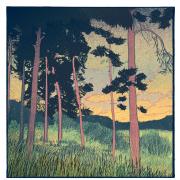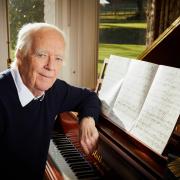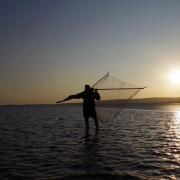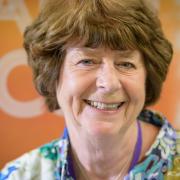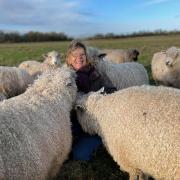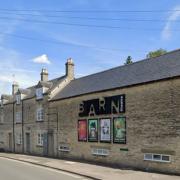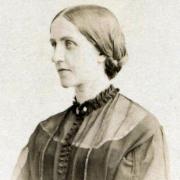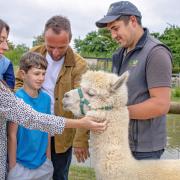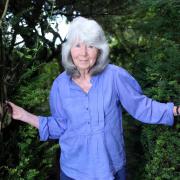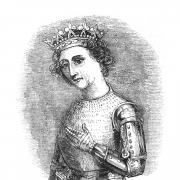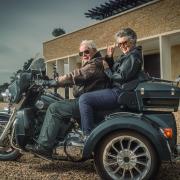Katie Jarvis talks to award-winning film-maker David Pearson about the Severn, our wonderful community spirit and his Cotswold life. Photography by Carl Hewlett

It was while cycling along the wild banks of the River Severn that award-winning film-maker David Pearson was inspired to create his latest production, Black Car Home. “I wondered what it would be like living there in winter, if you were homeless,” he says. The result is the story of Tatiana, a feisty illegal Latin American immigrant, rescued from the river’s freezing mud by Nathan, a rough giant of a man, who lives in a makeshift camp by the beach, and forages for food.

“I’ve filmed in wars and all sorts of wild places, and I’ve noticed how difficult environments are a real leveler. They strip away all the clutter - the ridiculous nonsense – that we get involved in in life. I was fascinated by the idea of someone being homeless on the banks of this river that is majestic, grand, sweeping, and with constantly-changing light. You really feel the blast of nature; you’re very conscious of being alive.”

Formerly married to the film director Jane Treays, he has two children: Emily, who works at Liberty, and Jago, a dance producer studying at Goldsmiths.

David’s partner, Katherine, is an economics teacher.

• Where do you live and why?
I live in Gloucestershire, by the River Frome. I love being close to water: it’s never the same for more than a few moments at a time. I’ve been gradually cycling up the River Severn with a good friend of mine, making our way from the mouth with the ultimate aim of getting to the source. I’ve travelled a great deal - in feast, famine and war – and I’ve been struck by how the Severn reminds me of some of those places overseas. There’s a sense of mystery: it’s beautiful, frightening, dangerous, and full of surprises.
• How long have you lived in the Cotswolds?
When I was working for BBC Bristol in the late 80s, I rented a cottage near Sheepscombe for a while. Years later, when Jane and I had the children, we were looking to get out of London. We started searching all over – even contemplating moving to Cornwall full-time, as Jane is Cornish. One day, I suddenly said, ‘What about Gloucestershire?’ We came down for the weekend, stayed in Painswick, and bought the first house we looked at.
• If money were no object, where would you live in the Cotswolds?
I’m very interested in old buildings. My father was an historic buildings surveyor who, at one time, looked after Brighton Royal Pavilion. I remember him taking me into the onion dome, where the servants’ quarters were. It was very basic – wooden hutches. My ideal would be to live on top of a hill overlooking the Severn, in an old stone house with a kitchen with a charcoal grill and bread oven that worked, a library and a small cinema, but with some trees and a river running past. A bit unlikely, given the geography!
• Where are you least likely to live in the Cotswolds?
In a tiny, ugly, new-build house with measurements that would have defined it as a slum just after the second world war.
• Where’s the best pub in the area?
We filmed in the Anchor in Oldbury-on-Severn, which is a nice pub and very helpful. My favourite locals are the Woolpack [in Slad], the George in Newmarket [Nailsworth], and the Crown & Sceptre [Stroud], which is the most amazing community pub.
• And the best place to eat?
That’s a thorny subject. I’m a foodie and former Gastronome of the Year, god help me. I even put Raymond Blanc on TV for the first time – in fact, one of the best meals I ever had was cooked by his mother. What drives me mad is that a lot of restaurants are very up and down: very inconsistent. I like William’s Kitchen [William’s Fish Market and Food Hall, Nailsworth] on a Saturday lunchtime; and I did enjoy the Crown in Frampton Mansell recently.
• Have you a favourite tearoom?
I don’t do tearooms very often but it’s great to be able to cycle along the canal to the Lavender Bakehouse in Chalford.
• What would you do for a special occasion?
Special occasions for me are often work-related - attending the BAFTA Awards, or a Black Car Home special screening such as the one taking place at the WWT Slimbridge Festival of Birds this month. One of the stars in the film is Olive, a whooper swan trained by Lloyd and Rose Buck, who work with David Attenborough. Lloyd will be at the screening, explaining how they get the birds to do the extraordinary things that they do.
• What’s the best thing about the Cotswolds?
Community spirit. Overall, 120 people did something to make that film possible. We received help from all over, including Wotton cinema [the Electric Picture House], the pub at Oldbury, and the yacht club [Thornbury Sailing Club], where we had a production office. We are also supported by our investors, the vast majority of whom live in Gloucestershire.
•... and the worst?
The planned Javelin county incinerator, the potholes, and people who drive too fast in narrow lanes. Oh – and the fact that I have lived in wild places, with no infrastructure, yet we get more power cuts here. Unbelievable.
• What’s the most underrated thing about the Cotswolds?
The people, born and bred. They’re rounded, deep, very open and kind.
• What would be a three course Cotswold meal?
Pigeon; venison, or something caught out of the Severn. (Severn salmon is fantastic, and I quite like elvers too, though they mostly go to Spain.) And the cheesecake made by Windrush Valley Goat Dairy, sold in Stroud market.
• What’s your quintessential Cotswolds village and why?
Probably Sheepscombe, though in some ways it’s atypical. It’s got a great cricket pitch – the Laurie Lee field – which has an angle on it that means it’s easy to score a six if you’re facing the right way.
• Name three basic elements of the Cotswolds
I’ve already mentioned the water so I’ll define it in terms of earth, fire and wind.
The produce, which actually tastes of something;
The fire is the artistry: every year, Peter and I cycle round the Stroud Open Studios [www.sitefestival.org.uk], which are wonderful;
And then the wind, whistling up the Severn.
• What’s your favourite Cotswolds building and why?
Wotton Picture House, one of the oldest cinemas in the country. It was closed for a period but, like a phoenix from the ashes, it rose again due to Jeff Walshe, his wife Janet, and their 120 volunteers (with a bit of help from the UK Film Council). I’ve nothing against watching DVDs at home – I do it all the time – but there is something about a shared viewing experience that’s unique. Recently, when they showed Mamma Mia, one couple got up and started waltzing. Said they hadn’t danced like that in years!
• What would you never do in the Cotswolds?
Camel-racing
• Starter homes or executive properties?
I have an interest in homelessness: one of my films, years ago, was the BAFTA-nominated Baglady, which was shown on BBC 1. The trouble is that the whole planning system is useless. When I lived in Painswick, I fought a campaign against plastering houses all up the Painswick Valley. There should be more houses built, but on brown-field sites. The politicians just can’t get it together to sort that out.
• What are the four corners of the Cotswolds?
Oldbury; Tewkesbury; Burford; Swindon.
• If you lived abroad, what would you take to remind you of the Cotswolds?
An unlimited supply of Old Spot beer from Uley Brewery.
• What’s the first piece of advice you’d give to somebody new to the Cotswolds?
Remember that the people who have lived here for a long time have made it the attractive place that has made you want to be here.
• And which book should they read?
Laurie Lee.
• Have you a favourite Cotswolds walk?
Anything that begins or ends with a view of the River Severn, so the Severn Way and any of the beacon or high-hill climbs. I love the strange things you find in the landscape. One walk, from the B4058 through the woods towards Uley, brings you to a row of trees with no earth underneath them, their roots exposed like stilts. Going inside them is like being in a miniature cathedral, and very Hobbit-like! Continuing to Uley and the legendary brewery (God’s own brew), you climb past the barrow towards Fairfeld, where you can catch a glimpse of the silvery Severn in the distance.
• Which event, or activity, best sums up the Cotswolds?
Stroud Farmers’ Market.
• If you were invisible for a day, where would you go and what would you do?
I’d go to the planning meeting that justified the Gloucestershire incinerator and paying Urbaser Balfour Beatty millions of pounds of public money, even if nothing went ahead!
• To whom or what should there be a Cotswolds memorial?
I like the unorthodox element to Gloucestershire – things like the Whiteway Colony and the Arts and Crafts Movement. People talk about Damien Hurst now but that sort of thing has been going on for 200 years. My memorial would be to the two women weavers in Painswick [Barron and Larcher], who would pay the local guys staggering out of pubs on a Friday night to fill a huge tank with urine, which they used in the dyeing process!
• The Cotswolds - aspic or asphalt?
Neither. Aspic goes mouldy; nor do we not want asphalt or inappropriate designs for rabbit-hutch estates, either. It’s shameful that brown-field sites are left empty while green sites are swallowed up. It is all driven by greed: we need a better planning system; and politicians who can better read building plans, and be more robust to big commercial developments and supermarkets.
• With whom would you most like to have a cider?
Chas from Uley Brewery because he won’t drink it. Now that would be funny.
***********
Jon Cleave, from the chart-topping Cornish folk band Fisherman’s Friends, will introduce a special screening of Black Car Home, in which he played a lead role, at WWT Slimbridge Festival of Birds on Saturday, February 1. The audience will have a chance to meet the local filmmakers David Pearson and Elizabeth Morgan (both Oscar-shortlisted and BAFTA and Emmy-nominated), as well as Lloyd Buck, who worked on Sir David Attenborough’s Flight series. See the trailer at www.blackcarhome.com
WWT Slimbridge Festival of Birds, on February 1 and 2, is held when bird numbers are at their peak counts and the reserve is looking its most beautiful. The festival is free for WWT members, or a special e-ticket can be purchased at www.wwt.org.uk/slimbridge
Black Car Home is made by Arturi Films Ltd, formed and run by David Pearson and Elizabeth Morgan Hemlock, www.arturifilms.com
---------
This interview by Katie Jarvis is from the February 2014 issue of Cotswold Life.
For more from Katie, follow her on Twitter: @KatieJarvis




